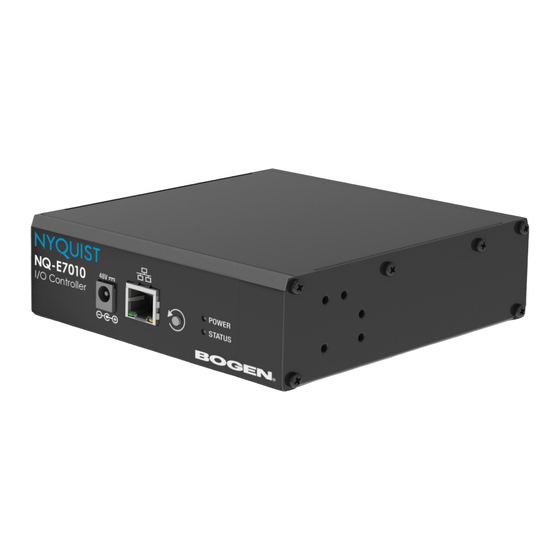Summary of Contents for Bogen NQ-E7010
- Page 1 Input/Output Controller Configuration Guide NQ-E7010 © 2021 Bogen Communications, Inc. All rights reserved. 740-00017G 211115...
-
Page 2: Table Of Contents
Contents Contents ............. . i Configuring the Nyquist Input/Output Controller . -
Page 3: Configuring The Nyquist Input/Output Controller
Configuring the Nyquist Input/Output Controller The NQ-E7010 Input/Output (I/O) Controller allows Nyquist to recognize third-party switch contact closures and to provide external circuits. Configuration rules can be set for each input and output port on this appliance. For example, you can set a rule that if a contact is opened, then an alarm will sound. - Page 4 Figure 1. Nyquist Appliance Login At the Nyquist Appliance Login page, enter username and password, and then select Login. The default username is admin; the default password is bogen. The dashboard for the selected appliance appears. Figure 2. I/O Controller Dashboard...
-
Page 5: Using The Dashboard
Using the Dashboard The dashboard displays the following fields: Table 1. Appliance Dashboard Fields Device Type Identifies the model of this device. Serial Number Identifies the serial number for the device. MAC Address Specifies the Media Access Control (MAC) address, which is a unique identifier assigned to network inter- faces for communications on the physical network seg- ment. -
Page 6: Updating Firmware
Updating Firmware When you select Firmware Update from the appliance’s web UI, the Firmware Update page appears. From this page you can determine which Nyquist firmware version the appliance is using and if an update is available. You can also load a firmware release, install the loaded firmware, restore the configuration to factory defaults, and reboot the appliance. -
Page 7: Network Settings Tab Parameters
Prompts the user to specify a firmware file, which will then be loaded (though not installed) onto the appliance. Note: To obtain the firmware file for a specific ver- sion, please contact Bogen Customer Service. Restore Factory Settings Returns the appliance to its original factory con- figuration. - Page 8 Figure 4. Network Settings Network settings are described in the following table: Table 4. Network Settings IP Address Identifies the IP address assigned to the appliance. Netmask Identifies the subnetwork subdivision of an IP net- work. Gateway Identifies the address, or route, for the default gate- way.
-
Page 9: Configuration Settings Tab Parameters
Table 4. Network Settings (Continued) TFTP Server Identifies the host name or IP address of the Trivial File Transfer Protocol (TFTP) server. The specified TFTP server can be used to automati- cally set this device’s Configuration settings via the Get Configuration from Server button. If TFTP Server from DHCP (see below) is set to “Yes”, this value will be auto-configured via DHCP option 66, assuming the DHCP server has been configured... - Page 10 To view the Nyquist appliance configuration: On the appliance Web UI’s main page, select Configuration Settings. View the configuration settings. Figure 5. Appliance Configuration Settings The following table describes the Configuration Settings tab settings: Table 5. Configuration Settings Get Configuration from Retrieves configuration settings (i.e., web username, server, and local port) from the TFTP server specified in Server...
-
Page 11: Accessing Log Files
Accessing Log Files A log file records events and messages that occur when software runs, to be used when troubleshooting the appliance. From the appliance’s web-based UI, log files can be viewed directly or exported via download to your PC, Mac, or Android device, where they can be copied to removable media or attached to an email for technical support. - Page 12 Table 6. Logs Description ampws.log Contains information about protection status and logs protection events with temperature information at the time of event. auth.log Contains system authorization information, including user logins and authentication methods that were used. btmp Contains information about failed login attempts. daemon.log Contains information logged by the various back- ground daemons that run on the system.






Need help?
Do you have a question about the NQ-E7010 and is the answer not in the manual?
Questions and answers